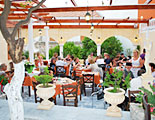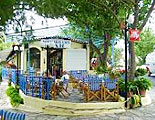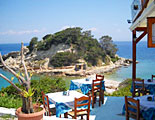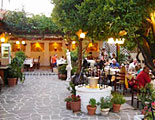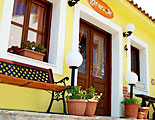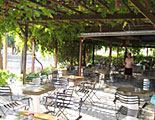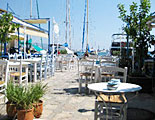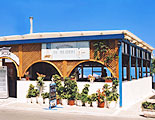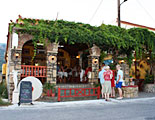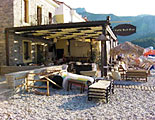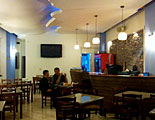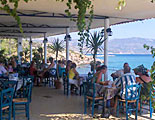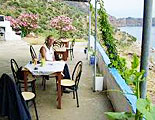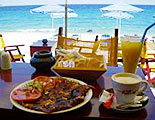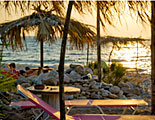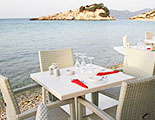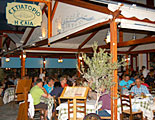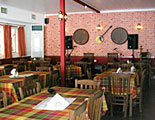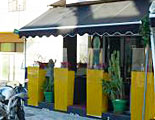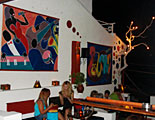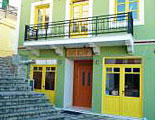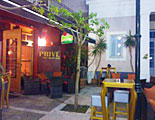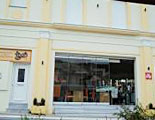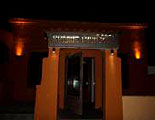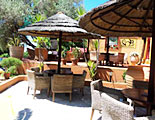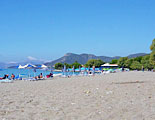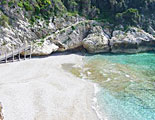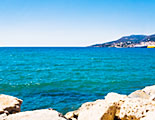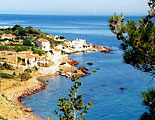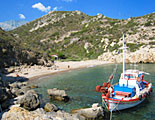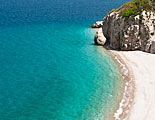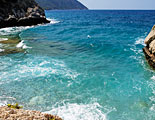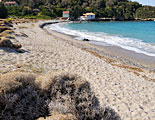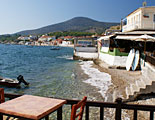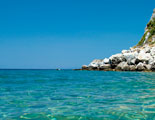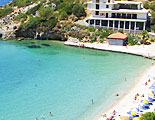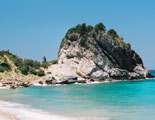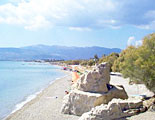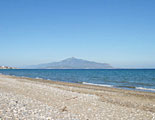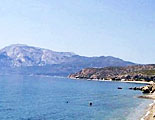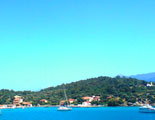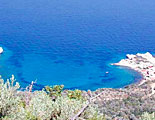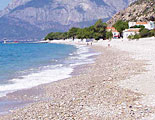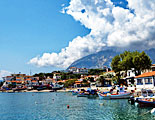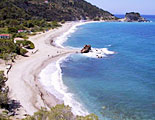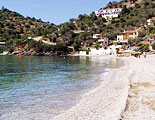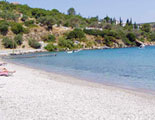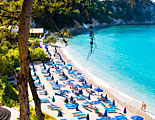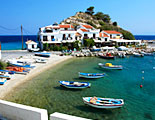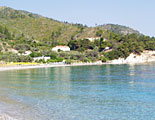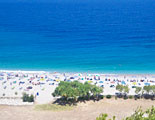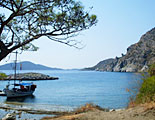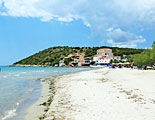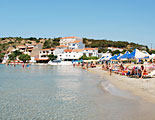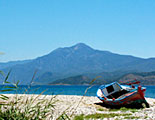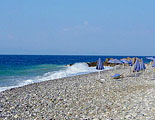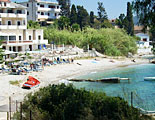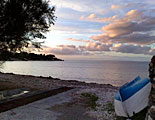 Samos Travel Guide
Samos Travel Guide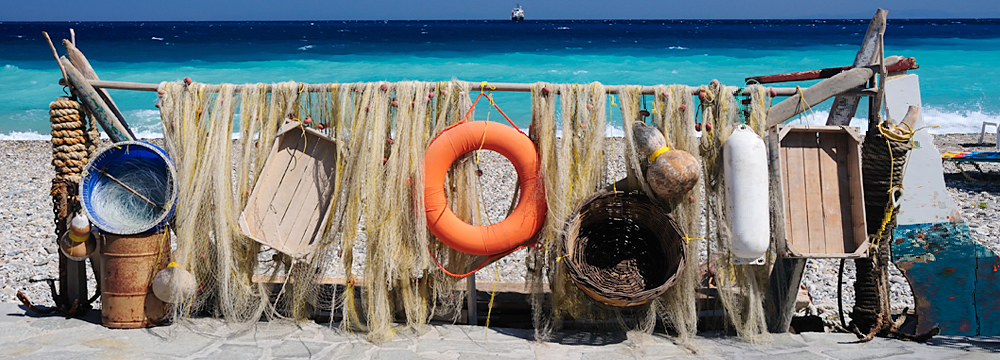
It is believed that Samos was inhabited around the 4th or 3rd millennium B.C. Findings from this period are exhibited in the Archaeological Museum of the island. It is not clear whether the Saians (“Saioi”) were the first island’s inhabitants or, as in other islands of the Aegean Sea, the Pelasgians were the first to settle here. Next to arrive were the Phoenicians and the Carians.
Samos’ decline continued in the Venetian Period, when the vast majority of the inhabitants left the island and went to Chios.
Samos resisted to the Ottomans during the Greek Revolution and managed to stay autonomous until 1830, when it was eventually granted to the occupants. In 1835, it became autonomous again but still belonged to the Ottomans. A big revolution against them was organized in 1849 and many Turks arrived on the island. Samos became part of the Greek State at the end of 1912.
The goddess Hera was massively worshiped on Samos as proved by the glorious ancient temple on the island. According to the Greek mythology, Hera was born and raised is Samos, where Zeus also proposed to her. There is a myth according to which Hera washed her hair in the river Parthenos. This is why many ancient texts refer to Samos as “Parthenia”.
It is situated in Vathy and it hosts amazing findings from antiquity, including marble, ceramic, bronze and ivory statues and objects, ancient jewels and many more. The most impressive exhibit is a 5.5 m. high “kouros” statue! The museum is open to the public Tuesday to Sunday from 08:30 to 15:00 and the ticket costs 3 Euros.
It hosts equally important and impressive exhibits, mainly from the Ancient and Roman Times, including Archaic columns, portraits of Roman emperors, ceramic objects from 7 centuries (9th to 2nd century B.C.) and amazing marble statues of various sizes devoted to Hera and other gods. This museum is also open to the public Tuesday to Sunday from 08:30 to 15:00 and the ticket costs 3 Euros.
This exceptional museum is located in Mytilenioi and it is a very interesting museum, since it hosts a plethora of paleontological findings, including about 300 kinds of minerals and rocks, shells and 350 species of fish, 40 species of birds, 30 species of animals, reptiles and amphibians of Samos and 3000 Greek herbs. This amazing collection is organized in separate sectors and the museum is open to the public from April to October Monday to Sunday from 9:00 to 14:00. For the rest months, visitors should call the museum and arrange a visit (service available for groups).
The Ecclesiastical and Byzantine Museum of Samos is situated in Vathy and hosts ecclesiastical objects, costumes, rare books and manuscripts from the 10th century B.C. and Orthodox images. It is open to the public Monday to Friday from 10:00 to 14:00.
The Samos Wine Museum located in Malagari (close to Vathy) is definitely worth a visit, since it offers a tour in the way wine used to be produced until a few decades ago. Exhibits include tools, barrels, tanks and lab instruments. The museum buildings are specifically designed so that visitors experience a journey in time and at the end, visitors can buy the amazing local “Moschato”.
Located in Karlovasi the Tannery Museum proves the long tradition of Samos in tannery which goes back to the Ancient Times. The museum represents the tools and methods of leather processing and visitors may also see a map with the dozens of tanneries situated in Samos during the 20th century. This museum is open to the public every day and there is no entry fee.
The most remarkable archaeological site at Samos is Ireo, in the homonymous area (3 km from Pythagorio). Archaeologists discovered in this location one of the most imposing and most important ancient temples which was of course devoted to goddess Hera. Visitors may sea part of the temple, the ancient altar and the road that connected the temple with the ancient city of Samos (i.e. Pythagorio).
Another amazing archaeological site is Efpalinion Orygma (or the trench of Efpalinos) at about 2 km. from Pythagorio. This ancient tunnel was specifically designed by Efpalinos and constructed in order to transfer water from the “Agiades” source to several places in Samos. Its length is 1036 m. (!) and it traverses the mountain “Kastro” from the northeast to the southwest 189 m. beneath the mountain peek. What is amazing is that the tunnel construction began simultaneously on both edges and workers met in the middle of the distance, with only 5 m. of divergence! The aqueduct was used until the end of the Roman Period.
Another place to visit in Samos is the Cave of Pythagoras, on the foot of mountain Kerki. It is a quite impressive cave where Pythagoras used to go when he needed isolation. This cave was also used by him as a hideout when Polycrates accused him of corrupting the youngsters of Samos. The cave is situated at about 3 km. from Kampos Marathokampou but the two thirds of the road are not covered with asphalt and the last 200 m. require climbing up more than 300 stairs. In the entrance of the cave, there is the picturesque chapel of Virgin Mary, built by Saint Paul Latrinos about a century ago.
Last but not least, the boatyard in Agios Isidoros is one of the two boatyards of Samos which have been preserved. Here there is one shipwright who still uses the traditional techniques of building and repairing wooden boats. The boatyard is situated at about 5 km. from Kallithea in western Samos, but the last 4 km. are not covered with asphalt.
Location: Votsalakia / Kampos Marathokampou
- Radio Taxi: +30 22730 28404
- Municipal Police: +30 22730 81100
- Samos Port Authority: +30 22730 27318, +30 22730 27890
- Hellenic National Meteorological service: +30 2109699101-3
- Elpa (Car breakdown tourist information service): 174
- Police: 100
- Fire Department: 199
- Ambulance: 166
Three kilometres (!) of golden sand and small pebbles await visitors in this beautiful beach, situated in the bay of Marathokampos in the south-western part of the island. The waters here are crystal clear and visitors may choose to relax on the sunbeds or underneath the tamarisk trees. The natural beauty of this area is amazing, since the beach is surrounded by beautiful hills. When the sun goes down, Votsalakia offers one of the top sunset views in the Aegean Sea!
Kampos is a tranquil beach in northern Samos with large white and light brown pebbles and usually big waves. It offers a refreshing swim in its cold, deep waters and attracts visitors who prefer serenity and relaxation as it is not organized. There are taverns and cafeterias near the beach and there are also other beautiful beaches next to Kampos, like Tsampou and Agios Konstantinos.
With turquoise waters and imposing rocky cliffs, the beach of Aspres certainly fascinates visitors at first glance. Although it is not an organized beach, it hosts a tavern where swimmers can buy refreshments, water and snacks, or enjoy a meal by the sea. The waters here are almost always calm and the morphology of the sea bottom is perfect for snorkeling explorations. Around Aspres there are many isolated beaches, accessible on foot.
Agios Nikolaos is a small, cozy beach on the northern part of Samos, right next to the homonymous settlement. The beach is small and picturesque, while a series of large rocks creates a tiny port, which however does not protect swimmers from the strong northern winds. There are taverns and cafeterias very close to the beach, but the beach itself is not organized.
Hidden between green hills that end in abrupt rocky cliffs, this gorgeous, turquoise waters’ beach strongly resembles to exotic beaches on isolated islands. There is golden sand on the beach and white pebbles at the first meters of the sea bottom. The amazing beauty of the beach is completed by the triangle-shaped rocky islets quite close to the shore. The rocks surrounding the beach are ideal for plunging and the beach is suitable for nudism.
Avlakia is a small beach with homogenous grey pebbles and deep, cold waters. The beach has tamarisk trees that offer natural shade and is ideal for a refreshing swim. The beautiful view of the hills covered with pine trees, the lovely color of the sea, the transparency of the water and the privacy at Avlakia guarantee a lovely and relaxing swim.
Mikro Seitani is an idyllic beach with turquoise waters, at the end of a small bay which is surrounded by pine trees. The area around the beach is a beautiful sea park, where lucky visitors can see Monachus-Monachus seals. Mikro Seitani has white pebbles and a rocky islet, and of course crystal clear waters. Access to Mikro Seitani, which strongly reminds the picturesque Ionian beaches, is possible via a path that begins at Potami (close to Karlovasi) or by boat.
At about 6 km. to the west after Karlovasi, Megalo Seitani compensates visitors who have walked down a path for longer than 3.5 km. The landscape is gorgeous with pine trees all around and the beach has golden thick sand. The wider area including Megalo Seitani and Mikro Seitani nearby is a sea park that hosts Monachus-Monachus seals. This beach is isolated and visitors should make provisions for water, snacks and hats, but it is definitely worth it.
Iraion is a picturesque beach in the southeastern coast of Samos, very well protected from the summer northern winds. The beach has sand and pebbles, and offers many amenities to visitors including sunbeds, umbrellas, taverns and cafeterias by the sea. Moreover, Ireo offers various accommodation choices as hotels and apartments are available at a walking distance from the beach. Last but not least, qiute a few interesting places to visit, like Pythagorio, and beautiful beaches like Potokaki are found very close to Ireo.
Varsamo is an isolated beach on the western coast of Samos. It is a fascinating beach with pebbles and rocks and transparent waters. Varsamo is ideal for tranquility and for those who seek wild beauty, untouched by the human hand. Since the west part of Samos faces the open sea, usually at Varsamo there are tall waves. Also drivers should be careful at the last 3 km. of the road leading to the beach, which are not covered by asphalt.
Gagou is a beautiful sandy beach with azure waters in north-eastern Samos, very close to Vathy. Here everything is easy; the waters are calm and shallow, access is very convenient (2 km. from the island’s capital), there are umbrellas and sunbeds, beach taverns and there are also varied accommodation options. Because of the easy access and services offered, Gagou is often preferred by families.
Potami is a large, tranquil beach in northern Samos, which has a unique shape; the beach is shaped like the number “3’, with a narrow piece of land entering in the sea and forming two unequal bays. The waters are crystal clear and have an amazing azure color, whereas there are no amenities offered on the beach. However, not very far from Potami there is a canteen and a restaurant.
Pythagorio is among the most famous holiday resorts in Samos. Its pebbled beach is not very large, but offers many amenities, including umbrellas and sunbeds and the option for various water sports (windsurfing, kayak, waterski, wakeboarding, etc.). At Pythagorio there is also a scuba diving school and the sea bottom is very interesting and attracts divers from all over the world. So, Pythagorio is the place to be for a fun and active vacation.
Among the longest beaches of Samos (3 km. long), this spacious sandy and pebbled beach usually has calm waters and offers many amenities. There are beach taverns and a cafeteria by the sea, umbrellas and sunbeds, different accommodation options nearby and water sports facilities. But what is truly astonishing at Potokaki are the dozens of tamarisk trees that lead the way towards the beach. A truly unique feature!
Strangely hosting a beach tavern, this tranquil beach creates the impression that you are on a virgin island. There are high rocky cliffs and impressively shaped rocks all around the coast, the area and in the sea, whereas the sea water is deep, cold and crystal clear. Being situated within the Marathokampos Bay, Pefkos is protected from the summer winds and offers an amazing swim in its tranquil transparent waters.
At Poseidonio the pebbles have an amazing uniform grey color! Visitors may choose to rest under the tamarisk trees or to lay on the sunbeds under the umbrellas. After a refreshing swim at the calm and transparent waters, visitors may have a delicious meal in one of the beach taverns serving traditional dishes. The area around the beach offers many accommodation choices, whereas right next to the beach there is a little port that welcomes boats and yachts.
Plaka is an isolated beach on the western coast of Samos, where access requires patience. Not only is it located at 63 km. from the island capital, but the last 5 km. of the road are a quite rough earth road. However, the wild beauty of Plaka with its huge rocks and its big waves compensates visitors, who of course need to make provisions for water, snacks and umbrellas. Plaka is one of those beaches worth discovering.
Balos is probably the only beach in Samos that features a lighthouse, which lies at the end of the beach on a jetty. The beach has thick pebbles and cold, clear and deep waters. There are a few sunbeds and some tamarisk trees, while the mountain on the right side of Balos creates a gorgeous scenery and a lovely sunset. Visitors need to make provisions for water and snacks.
Ormos Marathokampou is a picturesque fishing village in north-western Samos, featuring a little port and a small sandy beach. Next to the beach there are fish taverns and cafeterias, while it is organized with sunbeds and umbrellas. Around the beach, there are accommodation options, the beautiful church of Saint Nektarios, gorgeous houses of traditional Aegean architecture and a quite well organized nightlife. Ormos Marsathokampou has a bit of everything!
Karlovasi or Limani Karlovasou is a 1 km. long sandy beach on the north-western part of Samos, right next to the port of Karlovasi. The easy access makes it quite popular for Karlovasi inhabitants and for visitors that choose to stay in Karlovasi. The beach is very much affected by the northern winds and it is not organized, but there are taverns and cafeterias around. However, gazing to the endless blue horizon makes the Karlovasi beach worth a visit.
Limnionas is a medium-sized beach with thick sand and transparent waters. The beach is protected from the northern winds and its calm waters are ideal for a little boat trip and an exploration of the little isolated beaches next to it. In terms of amenities, Limnionas has sunbeds and umbrellas, and beach taverns that offer food and snacks. There are various accommodation options around the beach and the wider area is beautiful, with pine trees and rocks.
This gorgeous beach in the eastern coast of Samos is surrounded by hills full of pine trees whose reflection colours the sea water with an amazing emerald hue. The waters at Kerveli are usually calm, since the beach is situated in a beautiful bay. This beach is not organized, but there is a beach tavern serving food and snacks.
Lemonakia is a medium-sized beach with white pebbles and azure, crystal clear waters. The beach is organized and offers many amenities, including a beach tavern, sunbeds and umbrellas. Even the umbrellas and sunbeds are blue, a fact that makes the beach colored in blue and white, just like the Greek flag. Access to Lemonakia is easy, by car or motorcycle, and there is a beautiful path of about 200 m. among pine trees at the end of the itinerary.
Deep, clean waters and huge waves are the main characteristics of this lovely beach with sand and pebbles in the northern coast of Samos. Kokkari is the favorite destination of surfers, due to the strong winds and perfect waves. The beach is organized and hosts beach taverns, cafeterias and of course sunbeds and umbrellas. The area around the beach is among the top holiday resorts on Samos, offering different kinds of accommodation.
Tsamadou is a dazzling beach with crystal clear, azure waters and pebbles, while the pine trees around seem to hang right above the water. The beach is organized and also hosts a beach tavern. In order to arrive at Tsamadou, visitors must walk down a lovely path among pine trees. At the two edges of the beach, visitors should expect to run into nudists, since Tsamadou is included in the list of nudists’ beaches in Greece.
Tsampou is an impressive beach with thick pebbles, where on both edges of the coast there are abrupt rocky cliffs. The waters here are deep and crystal clear and quite often there are high waves. Tsampou is organized offering sunbeds and umbrellas, plus the ability to buy water, refreshment and snacks or have a meal at its beach taverns. Right next to the beach there is a smaller, isolated beach, which is also suitable for nudism.
Nestled in a long and narrow U-shaped bay, this stunning beach is totally isolated and requires organization on behalf of visitors, which must bring water, umbrellas and snacks with them. Access requires about 7 km. of earth road, but there is always the easier way of arriving at Tsopela by boat (tours that include Tsopela depart from Pythagorio). The waters here are calm, transparent and turquoise and swimming here feels like being in paradise.
It is not by accident that this beach is called Hrisi Ammos, since the phrase hrïsi ammos" means "golden sand" in Greek. This wide beach with light brown thin sand is surrounded by pine trees and offers many amenities. Visitors can enjoy a refreshing swim in the calm waters and then taste the local cuisine at either of the two beach taverns. Hrisi Ammos often attracts nudists.
Psili Ammos, which should not be confused with Hrisi Ammos or Psili Ammos in south-western Samos, is a 200 m. long beach with thin sand and very shallow calm waters, ideal for children. The beach offers sunbeds, umbrellas and the option of a meal by the sea, whereas the area around the beach offers various accommodation options. This is the ideal beach for a relaxing family vacation.
Mykali is a 3 km. long beach with beautiful, thick, light grey pebbles. A part of the beach is organized hosting umbrellas and sunbeds, while there are also canteens and taverns. But the beach also boasts parts (like on the left edge of the beach) that are almost never crowded and visitors may enjoy a tranquil swim. Moreover, several water sports are available at Mykali; this really is a diversified beach!
Svala is a quite long beach with pebbles, while at the right end of the beach there is a strangely shaped heap of rocks. The waters here are cold and very deep while there is no protection from the northern winds. Svala ia found at about 19 km north-west from the capital (Vathi) and you will find a canteen offering coffee, refreshments and snacks while it is mostly organized with umbrellas and sunbeds. One of the most charming coasts when no winds are blowing except you are an adventure lover!
In order to reach Roditses, visitors may park their car at Vathy and walk for a few minutes. Because of its proximity to the island capital, this beach is strongly preferred by the inhabitants of Vathy. There are sunbeds and umbrellas, whereas various dining and accommodation options are available around the beach. The waters here are quite shallow and the lovely white color of the sand combined with grey pebbles create a beautiful landscape.
Kedros is a beautiful pebbled beach in northern Samos, accessible via a dirt road. The beach has some colorful umbrellas and sunbeds, whereas it hosts a great tavern. At Kedros, there are medium height waves, a fact which makes them ideal for family fan. This beach is close to the capital and there are many gorgeous beaches around it, so visitors can combine a visit to Kedros with a visit to Kokkari or Tsamadou.
Wrapped in handmade dough and filled with a mixture of yellow pumpkin, onions, cinnamon, sugar, feta cheese and olive oil, “bourekia” are fried in a pan with olive oil and they constitute an excellent appetizer, both salty and sweet!
For this dish, the veal is sautéed with onions, fresh tomatoes, fresh mint, pepper, sugar and salt, and then it is wrapped in slices of fried eggplants. Apart from an amazing taste, this dish has an impressive appearance.
Made with potatoes, pumpkins, eggplants, tomatoes, onion, garlic and olive oil, and seasoned with salt and pepper, which are first fried and then boiled, this is a truly tasteful dish mixing all summer flavours!
The crayfish are first sautéed, with onions and red and green peppers, and then baked in a baking casserole with lid along with the pasta (could be spaghetti or any kind of pasta). The great taste is guaranteed by the fresh crayfish from the crystal clear sea of Samos while the special baking casserole preserves the aromas and flavours of the crayfish and diffuses them in the pasta.
This dessert probably goes back to the time when Samians left the island and went to live on Chios, since it uses a mixture of oil with crushed mastic that creates a unique aroma. The other ingredients are flour, warm water and yeast, olive oil, one egg and sugar. Once the katimeria are fried, syrup is poured on them and they are accompanied by cheese.
Samos was renowned from the Ancient Times for its wine and for certain other products, which were even then exported in Asia, various places of Greece and Egypt. The most famous Samos’ products you should definitely try and take home with you follow.
This excellent quality wine, called “Samos”, is exported all over the world and it is highly appreciated even in France. Demand for the Samos wine is increasing, but unfortunately the quantity of local production is restricted. Visitors should absolutely take a bottle of “Samos” with them.
More than 13.000 hives exist in the forests and plains of Samos producing more than 85.000 kilos of excellent quality honey. Great taste and high nutritional value in a jar!
Going back to 1910, when a woman established the first ouzo distillery in Samos, the production of ouzo on the island is still important while it is still perfomed by using the traditional techniques. Compared to the ouzo of other places, the ouzo of Samos has a lighter and finer taste. Another similar product is souma, which is a type of raki that can be found on the Aegean Islands. Do not drink too much though because dizziness is sure to come!
Samos has a long tradition in dairy products and visitors should taste the local myzithra and anthotyro (cream cheese). However, the most renowned, exceptional cheese of Samos is called “armogalo” which is made of fresh goat and cow milk and it has an amazing taste.
On Samos great quality olive oil and olives are produced. The most renowned olives of the island are called “hamades” (“hamo” means down on the floor), because they are gathered from the ground once they fall off the trees and consumed right away without any processing. They are hard to find and have a soft sweet taste. Find them and try them!
Samos is the paradise of herbs and, as such, the perfect place to buy oregano, fresh mint, basil, laurel, lavender, and many more. They add exceptional aromas in most dishes.
The art of pottery in Samos goes back to antiquity. Ceramic objects are produced today in laboratories using traditional techniques. This is a great chance to buy a decorative object or a useful utensil.
Samos is renowned for its citrus tree and especially for its oranges with a fine aroma. Oranges, lemons, tangerines, etc., are incredibly juicy and they are tasteful either fresh or in jams.
There are several events organized in Samos every year especially in summer. Events cover a wide spectrum of interest, including events related to agriculture, cultural events and religious feasts. In general, visitors of Samos during the summer have the opportunity to attend and participate in many events. Relevant information is available via the municipality of Samos.
During the Carnival period many festivities are organized in Karlovasi and in the surrounding villages when the locals wear costumes and walk around the area. There is the custom of “Kadis” which satirizes the Turkish judges and the custom of “fratzolia” (the word comes from “fratza” that means decoration) where participants wear anything they find and end up looking ugly and funny. On the last day of the carnival period there is a big parade with thematic carnival floats.
In mid-March local producers organize the Orange Festival which is held at the village of Myloi (close to Ireon). The festival includes free fresh orange juice, jams and candies made of orange. There is also a small outdoor market where visitors can buy oranges and tangerines at half price, but also other products like jam, honey, olive oil and hand-made jewels. This event is held at the village’s primary school’ yard with the participation of students!
During the summer, there are quite a few events, some of which are regular, like the Ireon Music Festival that is held on 7, 8 and 9 August at Ireo beach. The festival started in 2004 and many famous rock and reggae musicians and groups have participated so far. This is actually an amazing event with live music on the beach…a genuine beach party!
Another regular summer event is Karlovasia. It is a three-month festival, lasting all summer long, and it includes concerts, traditional festivities with live music, theatre plays, folk dancing by groups from several parts of Greece and sports’ events. The events are held in Karlovasi and in villages/areas nearby.
As in every Greek island, religious feasts are quite important and very joyful. The most interesting among them are the feast of Agia Paraskevi held on July 26 and the feast in honour of the Assumption of Virgin Mary held on August 15 in Hora, the feast of Agia Marina in Vourliotes on July 17 and the feast in honour of the Birth of Virgin Mary held at the amazing Monastery of Panagia Vrondiani.
The northern part of Samos is mainly affected by the strong estate winds, whereas the southern and eastern coasts have calm waters. When the wind is too strong, it is wiser to choose one of the island’s calm beaches.
Samos is a big beautiful island that has numerous beaches many of them only accessed through difficult earth roads. Moreover, the roads leading to some mountainous villages are rough. So renting a 4x4 vehicle is not a luxury, but a prerequisite in order to fully discover and utterly enjoy the island beauties.
The sea bottom is fantastic in this part of the Aegean Sea. The Samos Dive Centre in Pythagorio awaits visitors who want to live this unique experience.
Several isolated beaches, most of them located in the virgin western part of the island, are only accessible via boat. Moreover daily boat tours to the Turkish coasts are organized on a daily basis. Do not miss this opportunity and do not forget to carry your passport with you!
At about 3 km. from Karlovasi, in the area of Potami, the amazing waterfalls of Samos are found. Bathing suits and athletic shoes are required, along with water, hats and snacks. The first waterfall is easily accessible; however, the second one (5 m. high) requires a little climbing and possibly swimming in cold river water. The second waterfall is remarkably spectacular and it is definitely worth the trouble.
It is almost unbelievable but Samos features 4 wetlands which host a vast variety of birds, reptiles and mammals species. The wetland of Aliki in eastern Samos consists of a lake and a marsh, and hosts more than 125 species of birds during the summer months. The wetland of Glyfades is situated near Pythagorio and consists of two lakes (Mikri Glyfada and Megali Glyfada) that have water all year long and are interconnected. Moreover, the marsh of Mesokampos nearby (at 4.5 km from Pythagorio) is a quite big wetland that hosts migratory and endemic birds. The marsh of Hora is about the same size with the marsh of Mesokampos and also hosts endemic and migratory birds. It is a protected area boasting an amazing natural beauty.

 Print this page
Print this page